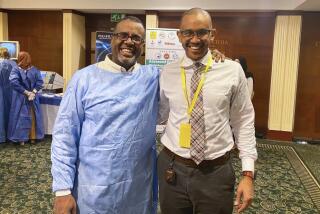Aga Khan of Today Raises Horses--and Humanity, Too
- Share via
KARACHI, Pakistan — The current Aga Khan’s grandfather was a distinguished statesman who served as president of the League of Nations, but he is better remembered for the occasions when devoted followers placed him on the scales and gave him an amount of precious stones, gold and platinum equal to his weight.
And the father of the present Aga Khan, Prince Ali Khan, served as Pakistan’s ambassador to the United Nations, but he is usually remembered for his stormy marriage to actress Rita Hayworth and for his death in a fiery auto crash outside Paris.
Prince Karim Aga Khan, 48, leader of the world’s 15 million Muslims of the Shia Ismaili sect, is probably best known for his string of fine horses (which included Shergar, the famous race horse stolen in 1983 in Ireland and still missing) and for his lavish tourist development on the Costa Esmeralda on Sardinia.
Lent House to Reagans
The Aga Khan attracted a bit more attention by lending his Geneva residence, the 18th-Century Maison de Saussure on Lake Geneva, to President and Mrs. Reagan for use during the summit meeting with Soviet leader Mikhail S. Gorbachev.
“Nancy Reagan asked if they could use it when we saw her in Rome a few months ago,” the Aga Khan explained.
But there is more to the Aga Khan than his houses and his horses.
While American technicians were busy moving the Reagans into the Maison de Saussure, the Aga Khan and his entourage were in Karachi dedicating the $300-million Aga Khan University Hospital. The architecturally stunning medical school and its 721-bed hospital make up the first private institution of its kind in South Asia. It will be linked with more than 125 rural health clinics operated by the Aga Khan Ismaili Charities in other parts of Pakistan.
Grandest Effort
Some Pakistanis have criticized the new medical complex, mainly because of its cost, but by the Aga Khan’s reckoning it is the grandest effort yet in the Ismaili-sponsored social development program, which includes not only the health clinics but 300 schools scattered across Pakistan, India, Kenya, Tanzania, Syria and Bangladesh.
Although he continues to battle the image of playboy and exotic maharajah, inherited from his father and grandfather, the shy, balding, half-English Aga Khan is building a solid international reputation for his Third World development projects, particularly in health and education.
The projects tend to be small--an iodine-enriched nutrition program in the Pakistani Himalayas is one example--but they are generally praised for their effectiveness and the return on investment. Recently, a Canadian aid agency and the Ford Foundation joined with the Aga Khan Foundation on some projects in Africa and Bangladesh.
“I wish people would just forget about the gold, the diamonds and Rita Hayworth,” a frustrated aide said.
Money for the good works comes from the zakah , the Islamic tithe, which was ordered by the Aga Khan as religious leader. Yet most of the Third World programs benefit non-Ismailis and are aimed at providing a positive image for the Ismaili community, a minority wherever it is found.
The Ismailis believe that their religious leader, or imam, is the direct descendant of Hazrat Ali, the Prophet Mohammed’s cousin and son-in-law. They believe that, beginning with Hazrat Ali, each imam chooses his replacement from his own family to rule over the community. Prince Karim Aga Khan is the 49th hereditary imam of the Ismailis.
Because of their belief, and their tightly knit community, the Ismailis have been discriminated against, even within the larger Islamic community. In Pakistan, where there has been increasing friction in recent years between the minority Shias and the majority Sunnis, newspaper articles have recently appeared charging that the Ismailis are not true Muslims.
Ismailis were expelled from Burma in 1962 and from Uganda in 1972. Even though more than half of them live in India and Pakistan, the Ismailis have become a mobile people, a fact illustrated by the Aga Khan’s choice of a Parisian suburb as his headquarters.
In the process of building his community’s image, the Harvard-educated Aga Khan has done much to improve the image of Islam, which has been tarnished by events in Iran and Libya, and also that of the United States, from which he imports medical and educational expertise.
U.S. diplomats in Pakistan are delighted with the Aga Khan University Hospital, which was designed by a U.S. architectural firm and is supplied by many American companies and staffed by a number of American medical educators.
The new head of the medical school, for example, is Dr. David D. Ulmer, a former chief of medicine at the Martin Luther King Jr. General Hospital in Los Angeles.
Ulmer talked in an interview about his new job here and compared it to what he did in Los Angeles.
“In a general sense,” he said, “it is a repeat of what we tried to do in Los Angeles. In both places (an effort is being made) to develop a new medical school in medically under-served areas. There are 2 1/2 million people living in the slums of Karachi whose health needs are great.”
Hospitals in Pakistan and throughout the Indian subcontinent tend to be Dickensian nightmares--filthy, overcrowded and understaffed, with the care likely to be worse than the disease.
Dr. Camer Vellani, chairman of medicine at the new Aga Khan Hospital, said: “My last hospital was a 1,350-bed institution situated on the edge of a slum here. It was a terrible place of treatment, but it was an absolutely perfect place for the practice of pathology.”
Vellani, 48, who has practiced in Britain, is one of a number of top-rank physicians drawn to the Aga Khan Hospital staff. He was already back in Pakistan when work started on the new hospital in 1981, but several other doctors came back specifically because of the hospital.
Dr. Sarwat Hussein, 39, a former Harvard fellow and radiologist at hospitals in Saudi Arabia, said that “if this had not come up, we would probably not have come back,” Curiously, Pakistan does not have a doctor shortage, as one might expect on the basis of other Third World examples. The problem with medicine in southern Asia has never been a shortage of physicians; the problem lies instead with sanitation, equipment and nursing.
The first facility built at the Aga Khan Medical School was the college of nursing, in part to improve the status of nurses in the society. Each student is provided with quarters that go beyond the standards of many American colleges.
Much of the complex is luxurious. There is marble wainscoting in all the buildings, and picture windows that look out on courtyards with marble benches. Walls are inscribed with fragments from the Koran, the holy book of Islam.
In addition to his other projects, the Aga Khan has been a champion of revived Islamic architecture and has set up special programs at Harvard and the Massachusetts Institute of Technology.
Despite the criticism that the medical complex is too lavish for Pakistan’s needs, what the Aga Khan is trying to do, according to his aides, is to give the country a living ideal against which it can measure other institutions.
“This is the biggest thing he has ever done,” an aide, Gerard M. Wilkinson, said. “His feeling is that something like this . . . will serve as an example.”
The lengths to which the staff will have to go to make it a working example was spelled out in the dedication speech of the hospital’s chairman, Shams Kassim-Lakha.
He mentioned the practice, widespread in this part of the world, of people spitting pan--or betel nut juice--in public buildings, and added: “Our nursing director is ready to hand a sponge and a bucket to the first person who spits pan on the hospital floor.”
More to Read
Sign up for Essential California
The most important California stories and recommendations in your inbox every morning.
You may occasionally receive promotional content from the Los Angeles Times.













